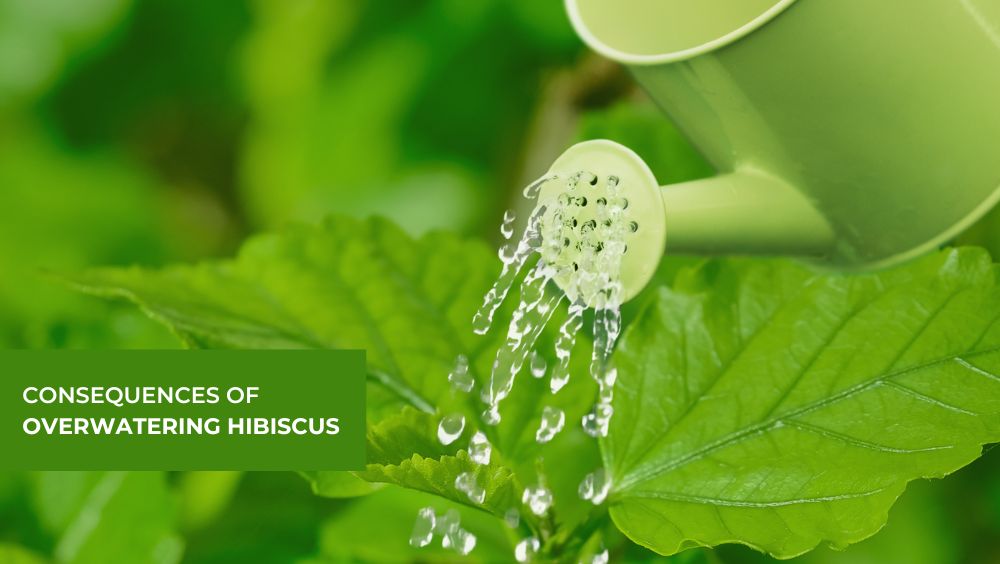
Hibiscus is undoubtedly one of the most attractive potted plants for balconies, gardens and terraces. And, just like any other tropical plant, they need plenty of moisture and humidity to thrive.
Unfortunately, there is a very thin line between maintaining the right moisture and waterlogging them. Which is why, overwatering is quite a common sight in Hibiscus especially among newbie gardeners.
But that’s understandable as frequent watering is one of many ways to display affection towards the plant. Then again, excessive watering poses serious problems in long term – Hibiscus cultivated in pots are particularly susceptible.
In this article, I will report my experiences with overwatering hibiscus and how I revived them from this stress.
How Does Overwatering Happen?
Insufficient knowledge concerning the water requirements of plants can quickly lead to overwatering. It’s an honest mistake in fact, as a way to compensate for the neglected care with an extra dose of water. Assuming we are doing plants a favor, we do more harm than any good.
But probably the biggest misconception is the interpretation of yellow leaves. When plants wilt or the leaves turn yellow, the first action for many is to water them. However, in most cases, the leaves droop or turn pale green/yellow due to nutrient deficiency.
And this deficiency is not due to substandard soil, which can be true if the plant has been in the same pot for many years, but is generally due to overwatering.
Waterlogging results from excessive watering or from a clogged drainage hole in the pot that prevents surplus water from seeping through. Covered pots are equally problematic as they do not allow the water to evaporate.
And if there is too much water in the soil, the roots are practically in an environment with no oxygen. This leads to rotting where the roots can no longer absorb nutrients, which then affects the entire plant. For this exact reason, Hibiscus eventually dies.
Frequent waterlogging means a slow death to your plant!
Common causes of overwatering
- Small pot size
- A poorly draining medium
- An inexperienced gardener
- Prolonged rainfall
How Do I Recognize Waterlogging In Hibiscus Plant?
There are some obvious signs indicating that Hibiscus has received too much water. First and foremost, of course, is that the soil in the pot will be extremely wet – and that too before watering. In some cases, you can see water dripping out of the drainage holes when you lift the pot. Clearly, if this happens, your Hibiscus is getting more than its fair share of water.
Besides these obvious signs, the soil around the plant will smell bad indicating bacterial or fungal infestation.
While watering if you observe that water does not penetrate into the soil and rather stays over the surface for several minutes, that’s another sign.
Lastly, an over-watered hibiscus plant will have wilted and yellow leaves. And in extreme cases, you may also observe leaf curl, indicating wilt disease.
To further explain, I am sharing few images of one of my overwatered Hibiscus plants.
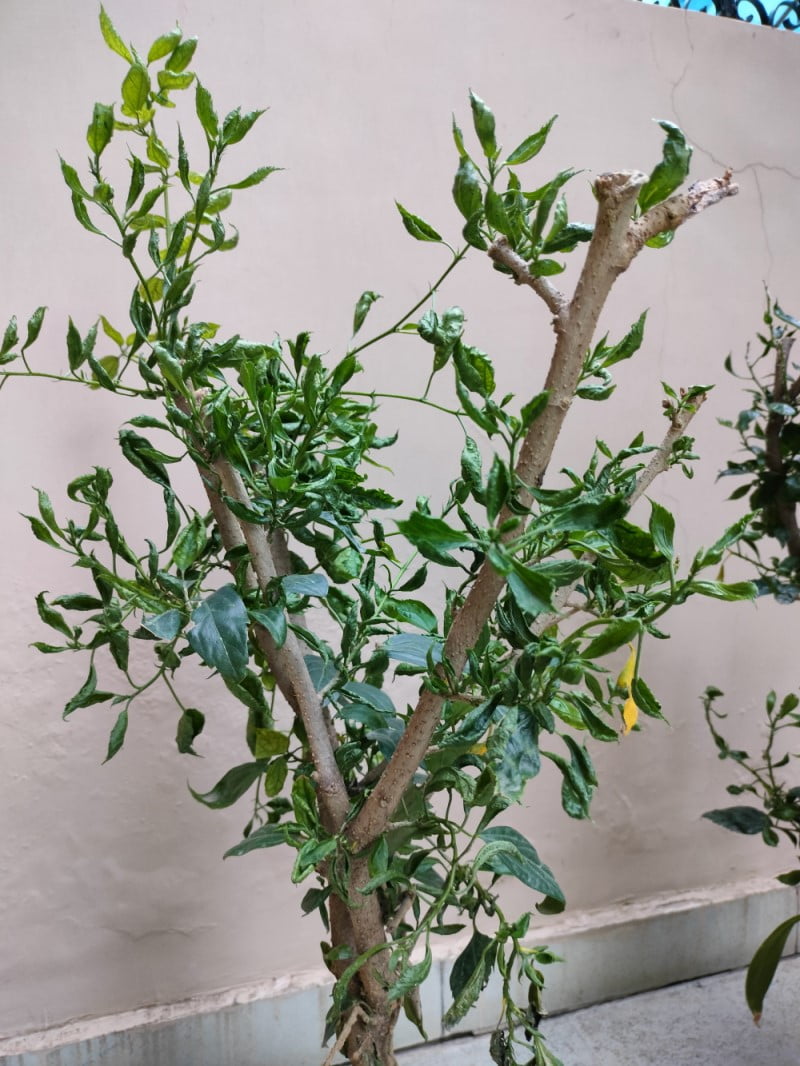
This Hibiscus was unknowingly overwatered for about a month back in the days when I was a novice gardener myself. And although none of the leaves lost their color, almost all of them curled – a typical symptom of wilt disease.
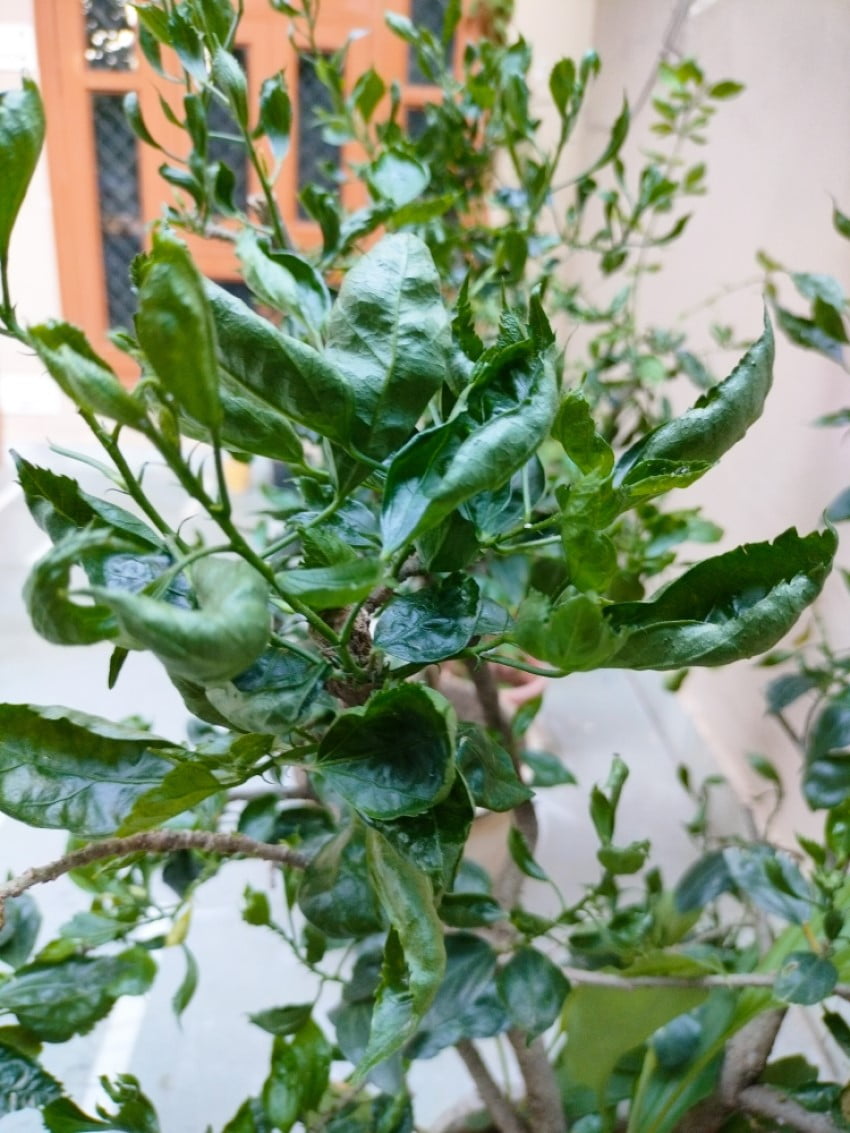
And since the plant was unable to absorb nutrients from the soil due to excessive waterlogging, it soon began to lose its immunity and its ability to withstand aphid attacks.
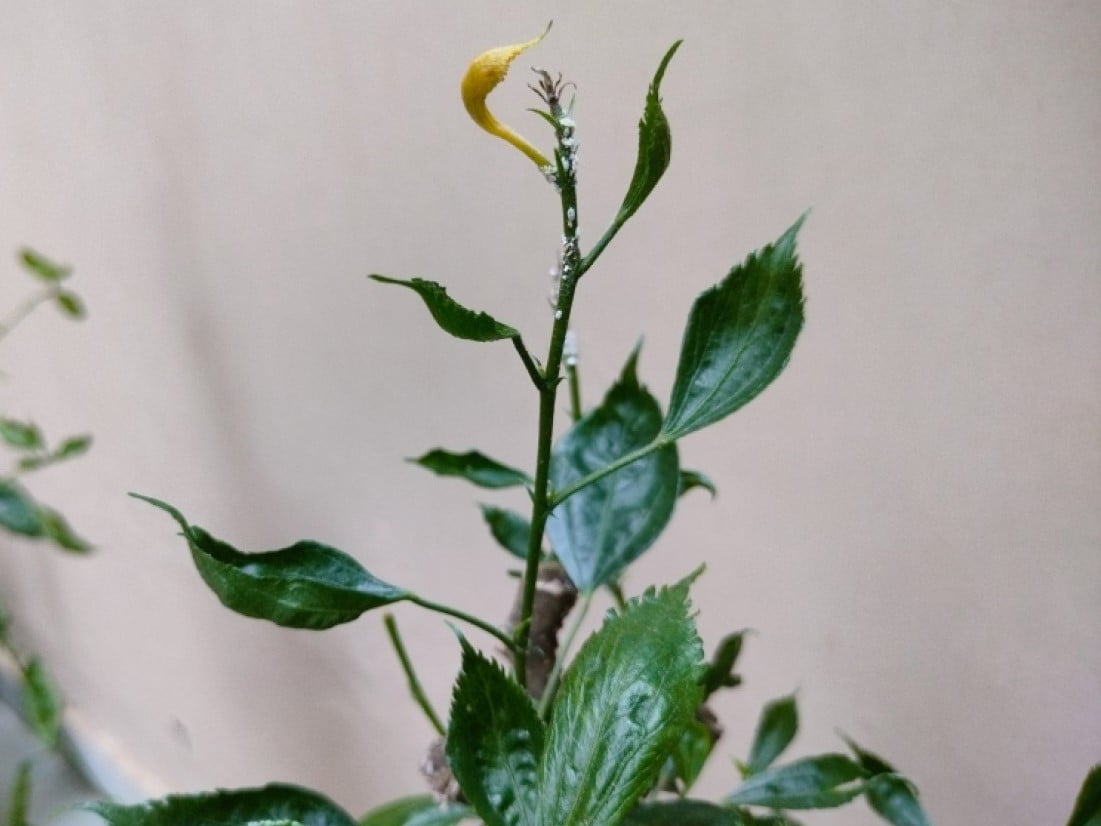
As you can see, apart from inadequate nutrition due to overwatering, this Hibiscus was later attacked by aphids and mealybugs. Unfortunately, this plant could not be saved as almost all the roots died and the plant succumbed to the bacterial and fungal infections triggered by overwatering.
What Happens If Hibiscus Gets Too Much Water?
When hibiscus gets too much water, it is often more damaging than temporary water deprivation. Too much water in the soil displaces air molecules, depriving the roots of vital oxygen and suffocating them. The plant then receives neither water nor dissolved nutrients.
Symptoms of overwatering include yellow leaves, necrosis, leaf burn, and wilt disease. This is why Hibiscus dies if overwatering continues.
Moreover, if your Hibiscus has been experiencing overwatering for quite a long time, any kind of revival technique won’t help. This is because an overwatered plant will begin to root rot.
Some typical signs of root rot in hibiscus are:
- Foul smelling soil
- Stunted growth of the plant
- Mushy stems
- Wilted, yellow, distorted leaves
However, if only some of the leaves are affected or the roots are not completely dead, there is a chance that you can bring the plant back to life by following certain procedures.
Can Hibiscus Revive Back After Overwatering?
To be honest, if the entire plant is wilted and shows no signs of healthy leaves, then it is best to just ditch the plant away. Reviving it would be nothing more than a waste of time. This is because in such cases, the plant suffers from complete root rot, that has already spread completely everywhere (as you can see in the images above).
However, if not all the leaves have withered, there is still hope that the plant can be revived. Even if most of the leaves have lost their color, that’s not a bad thing.
As long as the leaves are not completely wilted or have stopped developing new shoots or buds, you can fix your overwatered hibiscus.
To further elaborate how you can do this, let’s take a case of another potted Hibiscus plant (placed outdoor) that suffered partial root rot and yellowness due to prolonged rainfall.
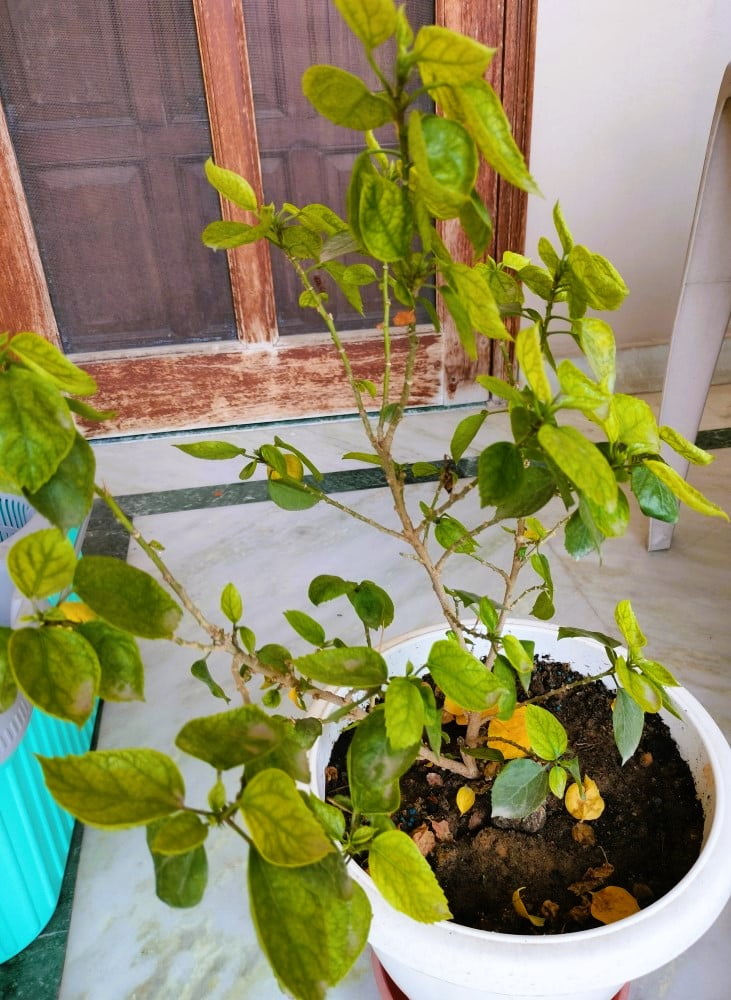
As you can see, this is what happened to this particular Hibiscus of mine owing to overwatering. If you notice, unlike the previous Hibiscus, this plant is not showing any signs of drooping. Instead, all the leaves have lost their original color and there are definitive signs of nutrition deficiency.
It is important to note here that this particular Hibiscus still has few green leaves intact. This indicates that the entire root ball has still not been affected by root rot and thus can be revived. Important thing here is to act quickly before it is too late.
So, the first thing to do in such cases is to remove the plant from the soil and analyze its root ball (taproots). Post which, prune few of the fibrous roots that look stressed (emanating foul odor) and cut back the stem that looks dead.
I recommend hard pruning in case the plant is in immense distress.
Once done, mix all the previous soil from the pot with some dry sand and cocopeat. You can also use fresh soil if you want, but its optional.
The plant should then be repotted and kept in semi shade.
Note: This is not a normal repotting procedure, so, do not add water at this stage.
The third day, before adding water to the soil, add some chelated micro-nutrients (4 grams) and magnesium salt (6 grams) on the surface of the soil. For better results, you can mix half this quantity in water for foliar application, while the rest can be added to the soil directly. This will greatly help the plant to absorb all the vital micro nutrients that it was unable to pick via its roots.
Now add water but only half of what you would normally do. This will ensure that the roots get the dissolved nutrients and none of them seep out.
Now wait for couple of days, or till the time the soil is completely dry (using 2-inch finger test that I will explain shortly). This time before adding water to the soil, spray (foliar application) equal ratios of NPK fertilizer (2 grams), like 20:20:20 or 19:19:19 over the leaves.

By following this procedure, I was able to revive my overwatered Hibiscus after around 40-45 days. As you can see, the plant has almost recovered from the stress and has started producing green leaves again.
Do note here, an overwatered Hibiscus plant will take a lot of time to recover. And chances are quite high that it may not bloom the following season.
Moisture and humidity promote fungal infections, so you should avoid waterlogging and keep the soil loose and well aerated.
All in all, these immediate measures will help you fix an overwatered hibiscus:
- If overwatering has only happened once or twice, you can use a tampon until it has been soaked up with water. The bigger the pot size, the more tampons you should use.
- If Hibiscus only has few discolored leaves, it is often sufficient to place it in a slightly warmer place than usual.
- Placing an overwatered Hibiscus in direct sun will do the opposite if the plant is not used to it. You can however place them under a fan.
- Under severe cases of overwatering remember to thoroughly analyze the plant and act before it gets too late – desperate times call for desperate measures!
How Much Water Does An Overwatered Hibiscus Need?
After you have nurtured your overwatered hibiscus with essential nutrients by repotting and fertilizing, you will need to perform a finger test to determine whether or not it needs water. Finger test is perhaps the best way to determine whether or not your hibiscus needs water.
To do this, simply stick your finger 2 to 3 inches deep into the soil. Depending on how dry the soil is, attend the soil by giving adequate water.
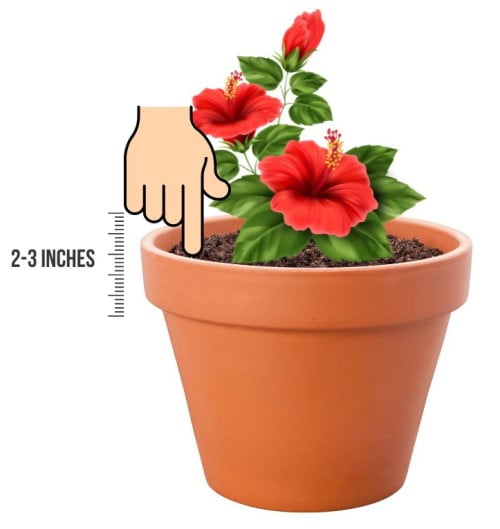
The moisture content in the soil:
Dry = A dry soil does not stick to the finger
Wet = A moist or wet soil covers the whole finger
If the soil sticks to your finger easily, you don’t need to water your Hibiscus. Leave it for another day and do the finger test again – it’s that simple. Remember, you don’t need to water your Hibiscus until the soil is dry (2-3 inches deep). But this does not mean that you can completely avoid watering assuming that only overwatering is bad. Underwatering is just as bad as overwatering, and therefore the soil should be inspected every day to determine the moisture.
Just as each person consumes different quantities of water, your plants do too. And even if you have a lot of hibiscus plants in pots of the same size, you should not assume that their frequency of watering should also be the same.
Water all the hibiscus once and then wait until the soil has partially dried. Depending on growth, root density and transpiration levels, each hibiscus will indicate different watering needs. For a more detailed guide, read this article on how often you should water your hibiscus.
Bottom Line
If your Hibiscus is exhibiting yellow leaves, brown tips, or showing signs of distress due to overwatering, it’s already at death’s door. Once root rot is ruled out, which requires immediate measures that we discussed above, there are certain steps that can help resolve the problem quickly.
- Dig up the soil with a shovel to a depth of about 2 inches to promote aeration
- Increase the air flow by placing the plant under a fan
- Poke a stick into the drainage holes to unclog them
- Remove old yellow leaves so that the plant can conserve its energy
- Use a tampon to soak up excess moisture
- And lastly, avoid watering an already moist soil
Good Luck!

